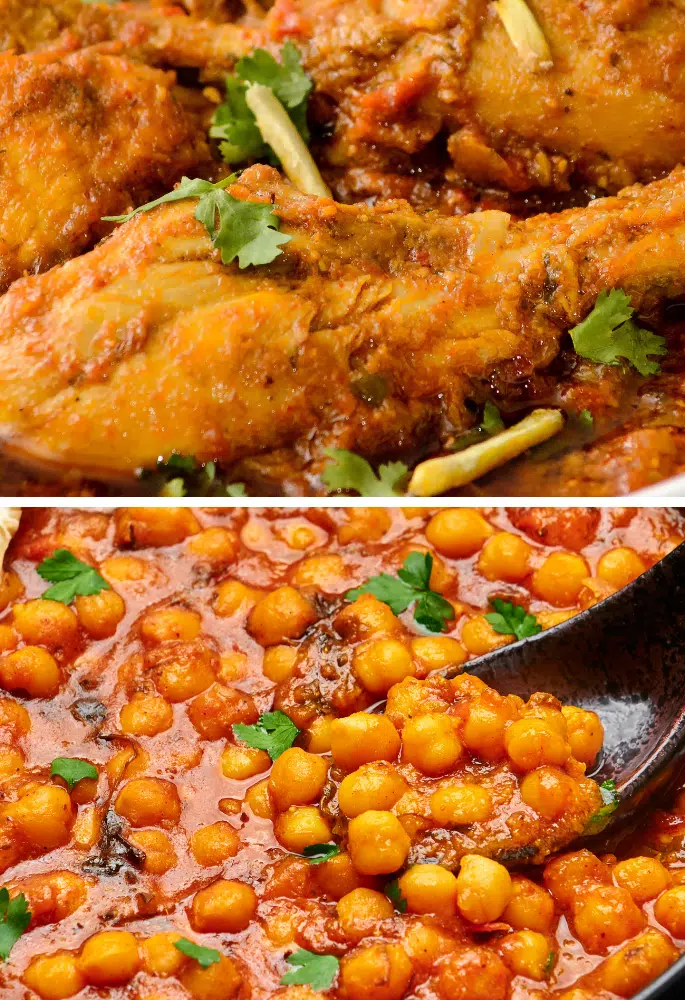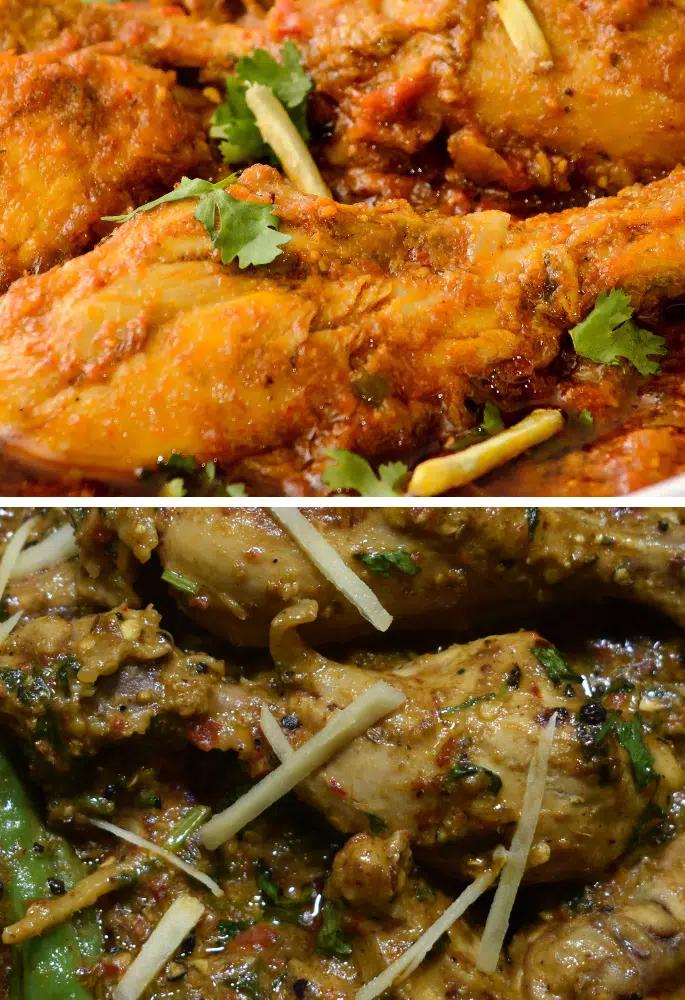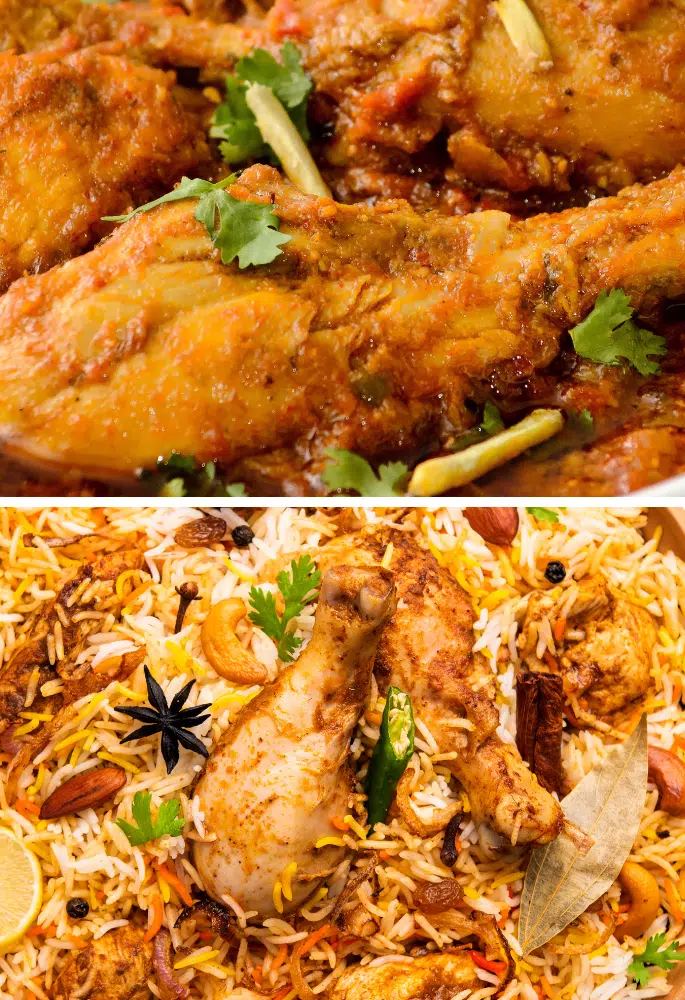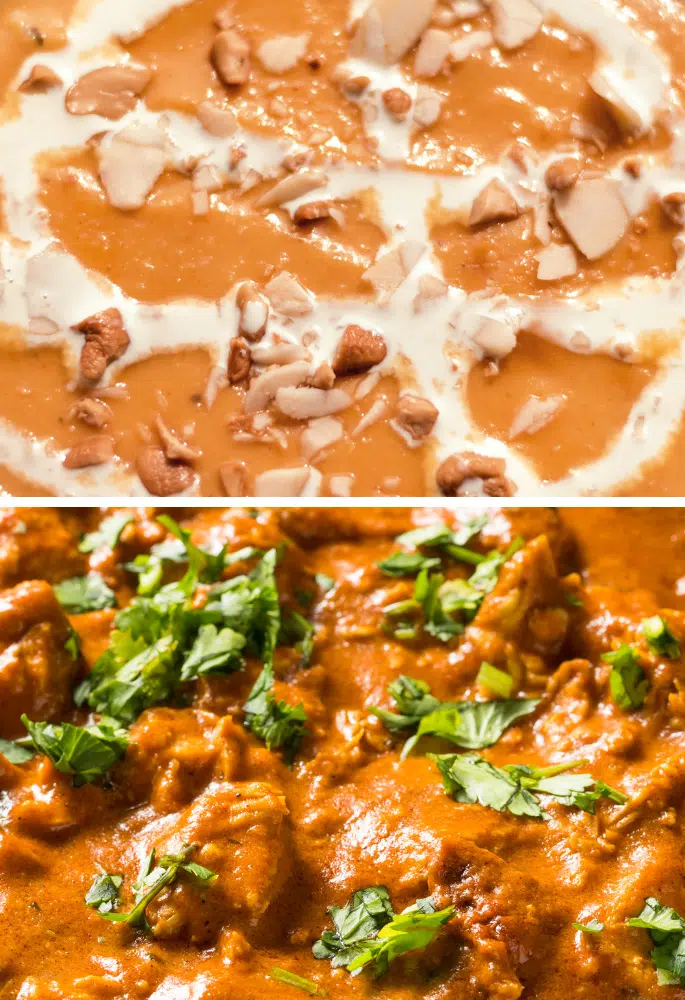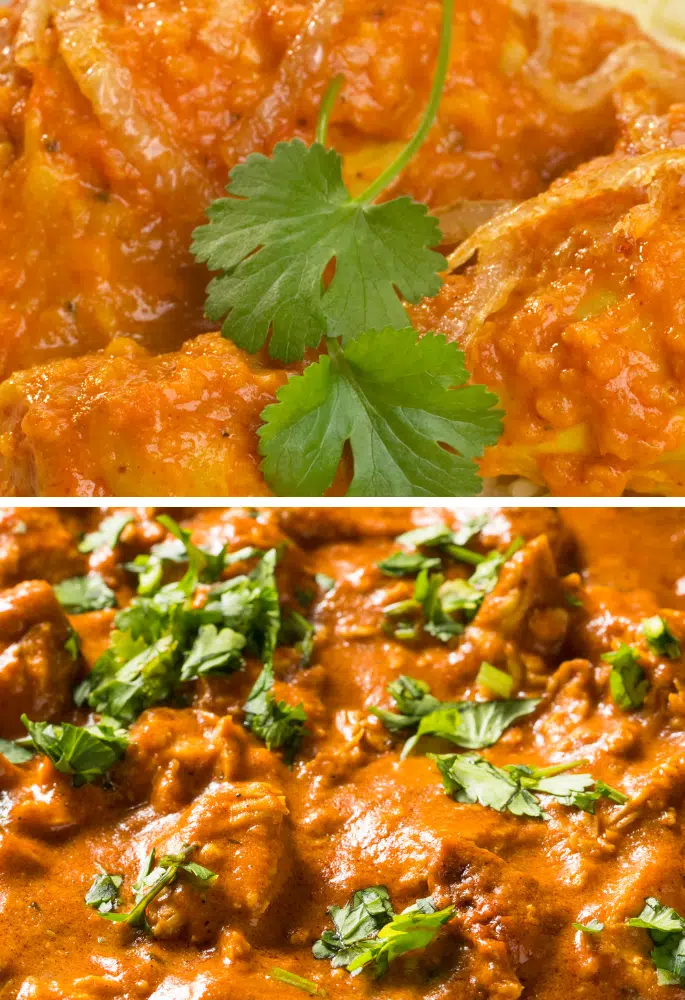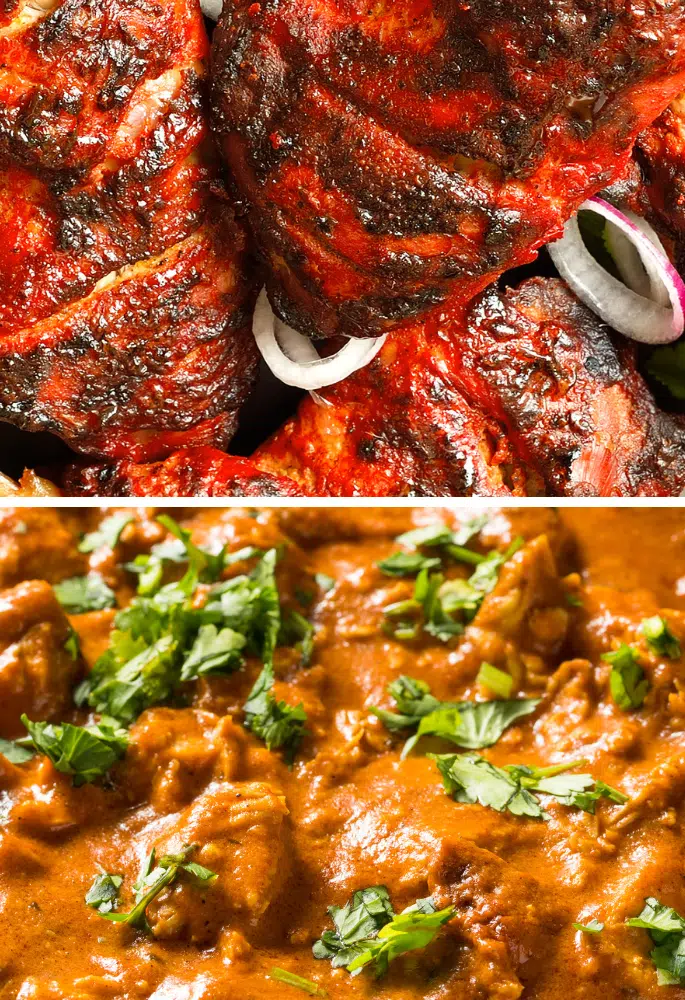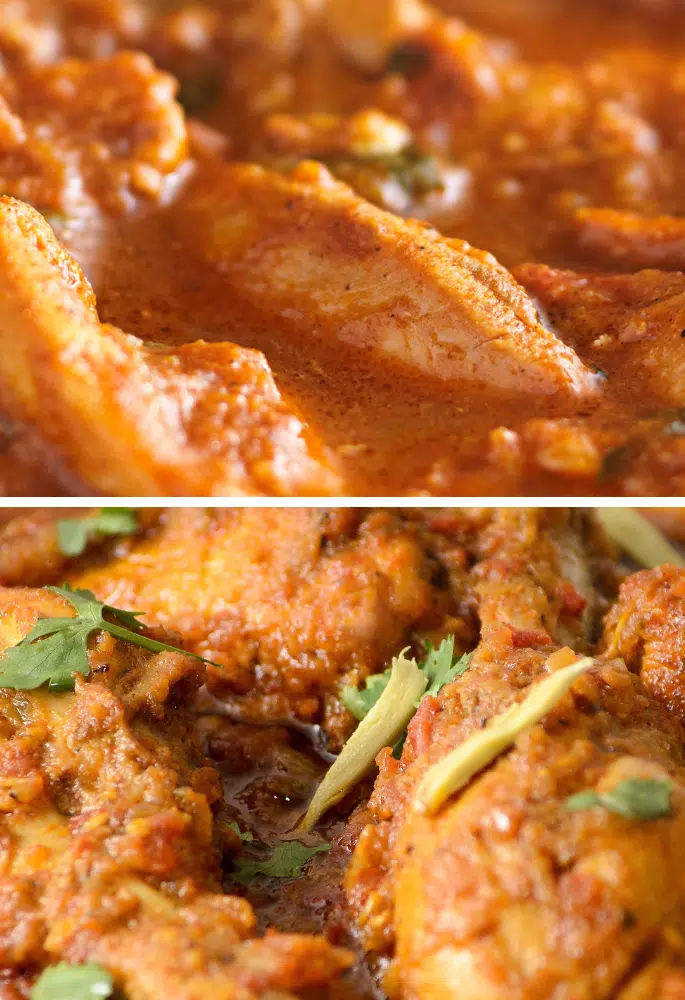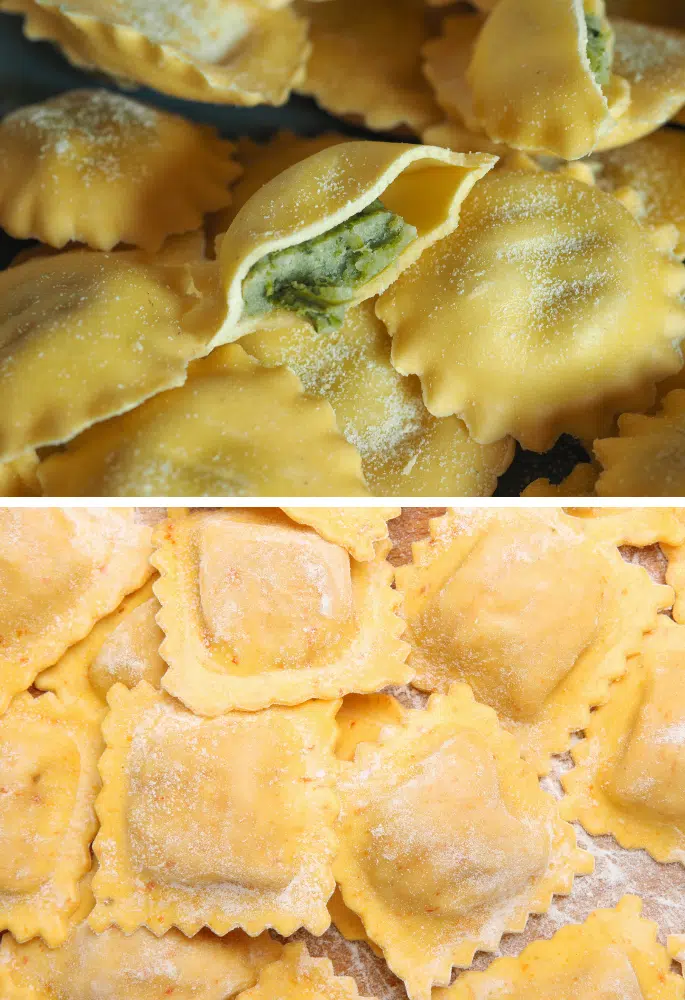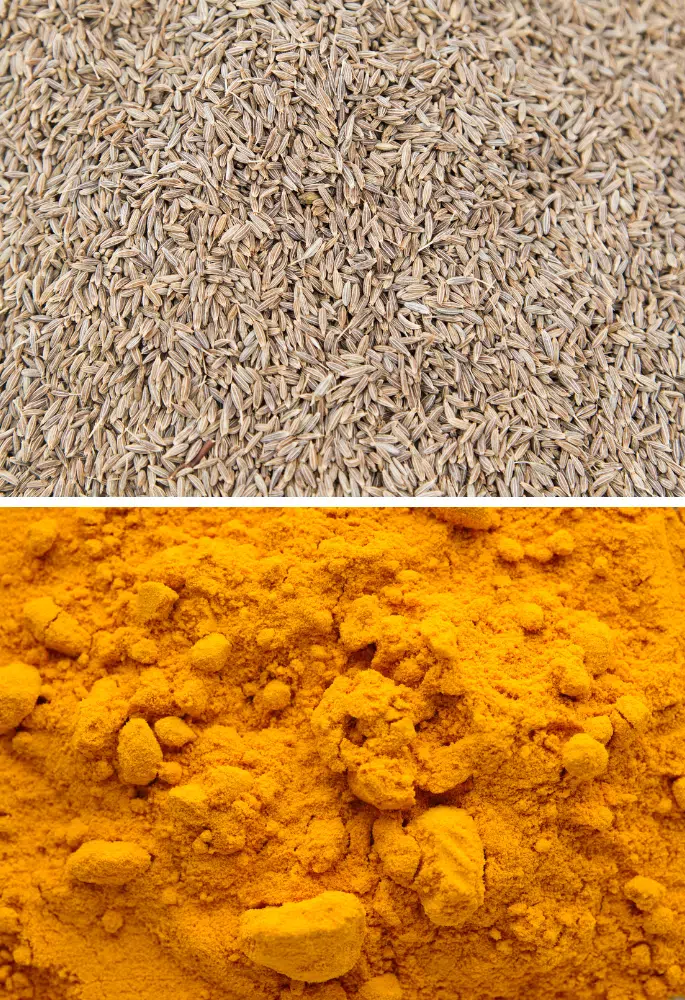You can probably list a handful of foods with 6 letters (many of them are pictured below). But, if you’re after a fairly extensive list of 6-letter foods then we have it for you.
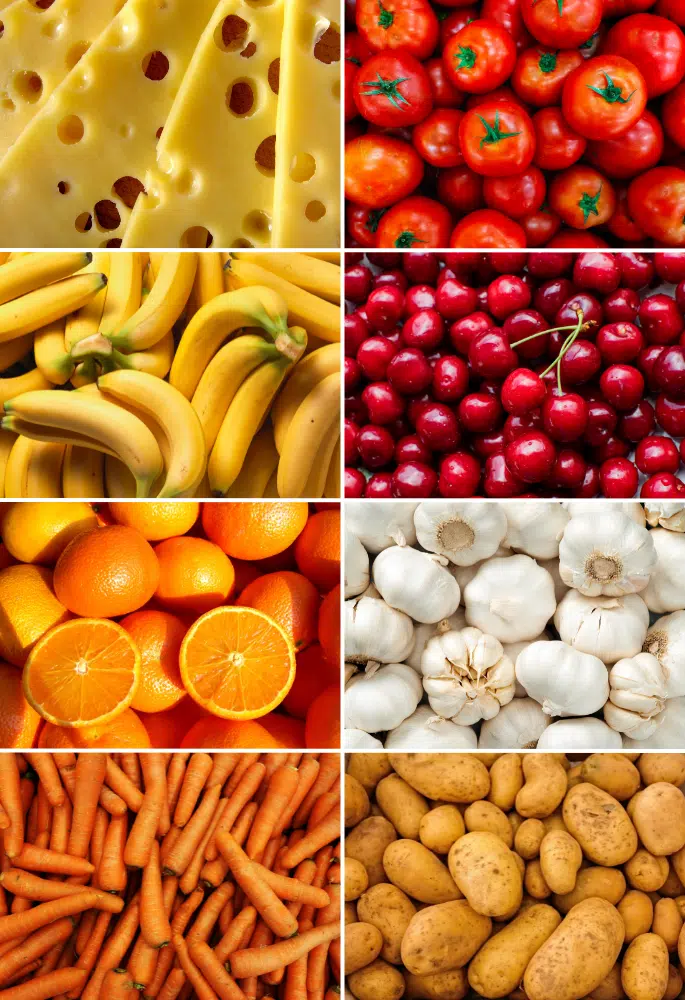
49 Foods with 6 Letters
Not only have we covered the obvious foods (like tomato and carrot) but we’ve also included some more obscure foods that you may not have thought of further down the list. But, let’s start with the basics:
1. Tomato
A versatile fruit often mistaken for a vegetable. Tomatoes are rich in lycopene, an antioxidant linked to heart health. Interestingly, the brighter the tomato, the higher its lycopene content.
2. Salmon
A popular oily fish, known for its pink flesh and rich flavour. Salmon is a great source of Omega-3 fatty acids, which are essential for brain health.
3. Banana
This curved, yellow fruit is packed with potassium, essential for maintaining healthy blood pressure. Did you know bananas can also help soothe an upset stomach?
4. Cheese
Cheese comes in countless varieties, from Cheddar to Brie. It’s a great source of calcium but should be enjoyed in moderation due to its high-fat content.
5. Orange
Not just the name of the fruit but also its colour! Oranges are famous for their vitamin C content, vital for a healthy immune system.
6. Garlic
A pungent bulb used widely in cooking. Garlic has been used medicinally for centuries, known for its potential antibacterial properties.
7. Papaya
A tropical fruit with a sweet taste and vibrant orange colour. Papaya contains an enzyme called papain, which aids in digestion.
8. Turnip
A root vegetable often overshadowed by its leafy greens. Turnips can be mashed, roasted, or added to stews for a subtle, earthy flavour.
9. Radish
A small, spicy root vegetable, often eaten raw in salads. Radishes are high in water content, making them a hydrating snack.
10. Squash
This term encompasses various vegetables like butternut and acorn squash. Squashes are rich in vitamins A and C and make for hearty autumn dishes.
11. Peanut
Technically a legume, not a nut, peanuts are high in protein and healthy fats. They can be eaten raw, roasted, or made into peanut butter.
12. Cherry
A small, round stone fruit that is sweet and juicy. Cherries are a good source of vitamin C and can help reduce inflammation.
13. Potato
A staple root vegetable, versatile in cooking. Potatoes are a good source of vitamin C and potassium, especially when eaten with the skin on.
14. Carrot
A root vegetable known for its bright orange colour and crunchy texture. Carrots are high in beta-carotene, which is converted to vitamin A in the body and is important for eye health.
15. Walnut
Tree nuts known for their distinctive wrinkled appearance and rich flavour. Walnuts are high in omega-3 fatty acids, which are important for brain health and can help reduce inflammation.
16. Celery
A crunchy, low-calorie vegetable often used in salads and soups. Celery is a good source of vitamins A and K and contains compounds that may help lower blood pressure.
17. Durian
Known as the ‘king of fruits’ in Southeast Asia, durian is famous for its strong odor, which some find unpleasant. However, its custard-like texture and rich taste make it a delicacy in its native region.
18. Quince
A lesser-known fruit related to apples and pears. Quince is hard and sour when raw but transforms into a sweet, delicate flavour when cooked. It’s often used in jams and jellies.
19. Lentil
A type of legume that comes in various colours like green, red, and brown. Lentils are a great source of protein and fibre and play a central role in many vegetarian dishes around the world.
20. Sorrel
A tangy, slightly sour leafy green often used in soups and salads. Sorrel is rich in vitamin C and adds a lemony zest to dishes.
21. Pomelo
The largest citrus fruit, resembling a giant grapefruit. Pomelos have a sweeter and milder taste than grapefruits and are popular in Asian cuisines.
22. Millet
A group of small-seeded grasses, widely grown around the world as cereal crops. Millet is gluten-free and used in making porridges, breads, and even beverages.
23. Borage
An herb with a cucumber-like flavour, used in salads, soups, and drinks. Borage flowers are edible and are often used as a garnish for their beautiful blue colour.
24. Kumara
A type of sweet potato commonly found in New Zealand. Kumara is versatile in cooking and rich in vitamins A and C, as well as fibre.
25. Bonito
A type of tuna, but smaller and with a milder taste. Bonito is often dried and shaved into flakes known as katsuobushi in Japanese cuisine, used as a topping or to make dashi broth.
26. Rambai
A tropical fruit found in Southeast Asia, rambai is similar to lychee and longan. It’s known for its juicy, sweet, and slightly acidic taste.
27. Yautia
A root vegetable also known as malanga or taro. Yautia is a staple in Caribbean and African cuisines, known for its versatility and can be mashed, boiled, or fried.
28. Daikon
A mild-flavoured winter radish common in East Asian cuisine. Daikon is often pickled, stir-fried, or used in soups and has numerous health benefits, including aiding digestion.
29. Lychee
A tropical fruit with a sweet and flowery flavour, covered by a rough skin. Lychee is rich in vitamin C and often eaten fresh or used in desserts and cocktails.
30. Parsley
A vibrant green herb, parsley is not just a garnish but a rich source of vitamins A and C. Its fresh, slightly peppery taste makes it a perfect addition to salads, soups, and sauces. Interestingly, parsley is also known for its breath-freshening properties.
31. Almond
This versatile nut, with its subtle sweetness and crunchy texture, is a favourite in both sweet and savoury dishes. Almonds are packed with healthy fats, protein, and fibre. They’re often used in milk alternatives and as a gluten-free flour option.
32. Bukayo
A lesser-known but delightful Filipino sweet treat made from young coconut and brown sugar. It’s chewy and rich, often enjoyed as a dessert or snack. Bukayo showcases the versatility of coconut in various culinary traditions.
33. Butter
A staple in kitchens worldwide, butter is made from churned cream. It’s loved for its rich, creamy flavour and is a key ingredient in baking. Interestingly, the quality of butter can vary based on the diet of the cows.
34. Damson
A type of small, tart plum, damsons are often overlooked but perfect for jams and jellies due to their high pectin content. In the UK, they’re also used to make damson gin, a unique and flavourful liqueur.
35. Endive
This leafy vegetable, with its slightly bitter taste, is often used in salads. Endives are rich in vitamins and minerals and are unique as they’re grown in complete darkness to prevent the leaves from turning green.
36. Fennel
Known for its liquorice-like flavour, fennel is a bulbous vegetable often used in Mediterranean cooking. It’s also great for digestion and can be eaten raw in salads or cooked in a variety of dishes.
37. Ginger
This root is famous for its spicy, fragrant flavour and numerous health benefits, including anti-inflammatory properties. Ginger can be used fresh, dried, or powdered and is a staple in many Asian cuisines.
38. Hotdog
A popular fast-food item, hotdogs are grilled or steamed sausages served in a sliced bun. They have diverse variations worldwide, reflecting local tastes and ingredients.
39. Hummus
A creamy Middle Eastern spread made from chickpeas, tahini, lemon, and garlic. Hummus is not only delicious but also a great source of plant-based protein and fibre.
40. Injera
This Ethiopian staple is a sour, spongy flatbread made from teff flour. It’s unique not just for its taste but also because it doubles as a utensil for scooping up stews and salads.
41. Jicama
A crunchy, sweet root vegetable often found in Mexican cuisine. Jicama is rich in fibre and vitamin C and is great raw in salads or cooked in stir-fries.
42. Kiwano
Also known as horned melon, this exotic fruit has a spiky orange skin and a jelly-like green interior. Its taste is a mix of cucumber, zucchini, and kiwifruit.
43. Museli
A breakfast dish based on raw rolled oats and other ingredients like fruits, nuts, and seeds. It’s often soaked in milk or yoghurt and is known for being a hearty, nutritious start to the day.
44. Muffin
A small, baked treat that comes in sweet and savoury varieties. Muffins are known for their moist, dense texture and are a popular choice for breakfast or snacks.
45. Noodle
A staple in many Asian cuisines, noodles vary in shape, size, and ingredients. They can be made from wheat, rice, or even beans and are used in a myriad of dishes, from soups to stir-fries.
46. Oyster
These shellfish are not only a delicacy but also play a crucial role in marine ecosystems as natural water filters. Oysters have a unique salty and slightly sweet taste and are often eaten raw.
47. Paella
A famous Spanish rice dish, paella is known for its rich flavours and variety of ingredients like seafood, meats, and vegetables. Its vibrant colour comes from saffron, a key spice in the dish.
48. Pandan
This tropical plant is used in Southeast Asian cooking for its unique, sweet aroma. Pandan leaves are often used to flavour rice, desserts, and even drinks.
49. Quinoa
Hailed as a superfood, quinoa is a grain high in protein and gluten-free. It’s versatile, easy to cook, and can be used in salads, soups, or as a rice substitute.
Other Lengths
Looking for Foods with Other Letter Counts? Click the Relevant Link Below:
Lewis is the founder and editor of Let’s Foodie alongside other food-related platforms including FreezeIt and SubstituteIt. He launched Let’s Foodie to provide aspiring cooks with one place to get the answers to some of the most commonly asked cooking questions.

